11 Best ReportGarden Alternatives in 2025
ReportGarden is a simple reporting tool for basic needs, but it can quickly become limiting as your business scales up.
To help you find the best ReportGarden alternative, I did three things:
- Spoke with our customers who previously used ReportGarden.
- Scoured online reviews and community forums for tool recommendations.
- Consulted our data engineers for technical details of each tool.
You'll also find a detailed table comparing 20 different features of each alternative tool.
Let's gooo.

Nov 15 2024●10 min read
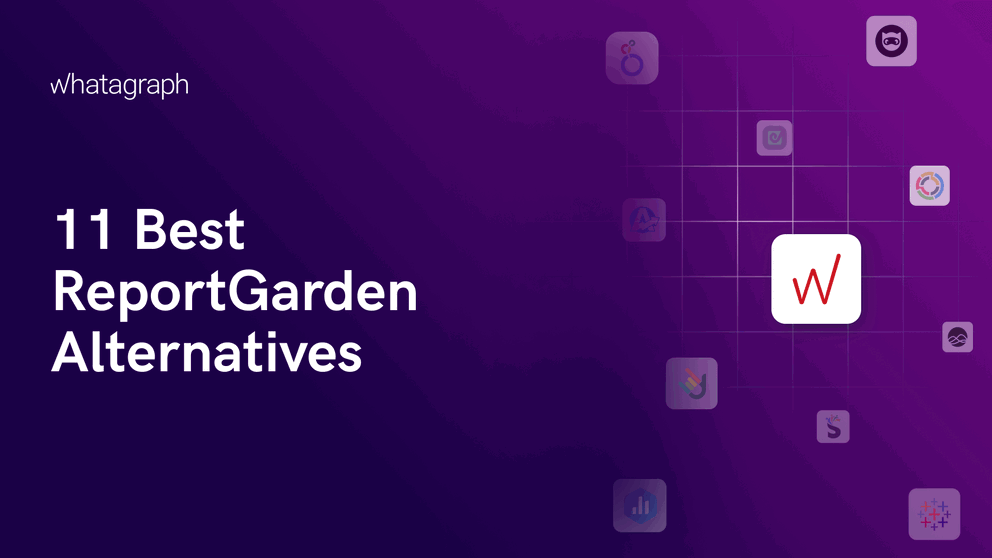
According to past users and online reviews, here are the biggest pains of ReportGarden:
❌ Time-consuming: Creating visualizations requires juggling dashboards, documents, and reports. For example, to make a single report, you need to create multiple pages, add widgets, create data blends, choose color schemes, e.t.c.—and then repeat this entire process to create a live dashboard.
❌ Slow: If you want to do anything on ReportGarden—like add new metrics, open up a report, or change date ranges on a report—it can take minutes to load.
❌ Data inconsistencies: Users say metrics from platforms like Google Ads and Google Analytics are often pulled incorrectly, resulting in inaccurate reports.
❌ Below-surface insights: ReportGarden does come with basic data blending and “Calculated Metrics”, but that’s where it ends. You can’t dig deeper into your data—for instance, you can’t analyze performance by Account Manager, location, or client’s business type. There’s also no option to view all the key metrics for a particular client or an Account Manager in one place.
❌ No AI insights: You need to analyze each report manually to unearth actionable insights and next steps.
❌ Unappealing reports: Based on examples we’ve seen, ReportGarden’s reports look outdated with limited customization—e.g., no widget resizing, restricted icon choices, and rigid layouts. Clients also need logins to view reports, adding friction to the process.
---
If you’re frustrated with ReportGarden, we’ve got your back.
In this article, we’ll take you through 11 best ReportGarden alternatives which are easier to use, stable, and reliable.
11 Best ReportGarden Alternatives and Competitors in 2025
In a nutshell, here are the 11 best ReportGarden alternatives we’ll review in this article:
- Whatagraph
- Tableau
- Geckoboard
- Looker Studio
- AgencyAnalytics
- Swydo
- Databox
- DashThis
- Grow.com
- NinjaCat
- Tapclicks
Have a set of features you’re looking for in an alternative? Compare them in this table:
| Features |
|

|

|

|

|

|

|

|

|

|

|
|---|---|---|---|---|---|---|---|---|---|---|---|
| Ease of use | Easy | Medium | Easy | Hard | Easy | Easy | Medium | Easy | Medium | Medium | Easy |
| No. of Out-of-the-box Data Connectors | 55+ | 100+ | 90+ | 21 | 80+ | 32 | 100+ | 34+ | 75+ | 150+ | 200+ |
| Custom API Access |
|
|
|
|
|
|
|
|
|
|
|
| Data Blending |
|
|
|
|
|
|
|
|
|
|
|
| Custom Metrics and Dimensions |
|
|
|
|
|
|
|
|
|
|
|
| Custom Reports and Dashboards |
|
|
|
|
|
|
|
|
|
|
|
| Campaign Overview and Monitoring |
|
|
|
|
|
|
|
|
|
|
|
| White-labeling |
|
|
|
|
|
|
|
|
|
|
|
| Data Update Frequency | Every 30 mins across all integrations and pricing plans | Default is every 12 hours but you can set custom frequencies | Depends on data source, from 1 to 60 minutes | Depends on APIs, from 15 mins to 4 hours | Depends on APIs, but SEO rankings update every 24 hours | ? | Depends on APIs and your pricing plan, from 1 to 24 hours | Once a day or on-demand update | Custom frequency - from 15 mins to 1 hour | Every day or manual data refresh | Automatically everyday or manual refresh |
| Data Segmentation and Filtering |
|
|
Filters for Google Analytics widget only |
|
|
|
|
Only for select data sources |
|
|
|
| Alerts and Notifications |
|
|
|
|
|
|
|
|
|
|
|
| Multi-Client Management |
|
? |
|
|
|
|
|
|
|
|
|
| User Management | Admin, Manager, or Editor roles | Creator, Explorer, or Viewer roles | Admin and View Only roles | Viewer, Editor, or Owner roles | Staff User or Client User roles | Admin, Editor, or Contributor roles | Administrator, Editor, User, or Viewer roles | Every user of the same account are considered "Admins" | Admin, Architect, Analyst, Visualizer, Consumer, or View Only roles | System Admin, Standard User, Restricted Partner, Dashboard User, Account Executive, and more | Super admin, Business unit admin, Agent, Client roles |
| Automated Report Sharing |
|
|
|
|
|
|
|
|
|
|
|
| Data Export | PDF, XLS, CSV | PNG, PDF, CSV |
|
Google Sheets, CSV, Excel (only chart level) | PDF, CSV | PDF (only for reports) | PDF, JPG | PDF only | CSV | Email, PDF | Excel, Google Sheets, CSV |
| AI Insights |
|
|
|
|
|
|
|
|
|
|
|
| Customer Support | Live chat, email, Help Center for all pricing plans | Tableau community forum, Help Center, Email, Consulting services | Live chat, Email, Help Center | Help center, community forums | Live chat, Email, Help center | Live chat, Email, Help center | Live chat, email, Help Center | Email, Help Center for all pricing plans | Live chat, Phone, Email, Help Center | Live chat, Email, Help center, Academy | Email, Help center |
| Dedicated Customer Success Manager |
|
? |
|
|
|
? |
|
|
|
|
|
| Data Security and Compliance | ISO 27001, Enterprise SSO, GDPR compliant, AES-256 encryption, Two-factor authentication, AWS hosted servers | MFA, SSL/TLS encryption, ISO 27001, ISO 27012, ISO 27018, GDPR and CCPA compliant | AWS hosted servers, HTTPS (128-bit TLS), RBAC, PCI DSS compliant | ? | MFA, Enterprise SSO | ? | ISO 27001, GDPR complaint, SSL encryption, passwords stored in virtual vault | Encrypted URLs, Password protection, Restrict IP addresses, GDPR compliant | SSL encryption, SHA-encrypted passwords, Two-factor authentication, SOC 2 certified, GDPR compliant, DigiCert SSL, OAuth connections | GDPR complaint, DDOS protection, data encryption, MFA, RBAC | HIPAA, SOC 2 Type II and SOC 3, HTTPS/TLS 1.2+, MFA, SSO |
|
Pricing
(with $$$ being the highest)
|
$ | $$$ | $ | Free for native connectors | $ | $ | $ | $ | $$ | $$ | $$ |
Let’s dive into each of these tools.
1. Whatagraph
Most suitable for: Medium to large marketing agencies with 10+ employees
If you’re looking for an easy to use platform with powerful data transformations and excellent customer support, Whatagraph is for you.
Whatagraph is an all-in-one data platform that makes it easy to connect, organize, visualize, and share your data in one place.
Here’s how it works:
- Connect to your data sources and channels in a few clicks. Your data will flow in automatically.
- Organize your data, create blends, and make custom metrics and dimensions, without writing any codes.
- Visualize your data using drag-and-drop widgets or ready-made templates. Create white-labeled reports with custom logos, domains, and color schemes.
- Analyze your data by client, campaign, Account Manager, or more. Spot trends, compare performance, and get actionable insights.
- Share reports as live links, PDFs, Excel spreadsheets, or automated emails. Or, transfer your data to BigQuery, Looker Studio, and/or Google Sheets.
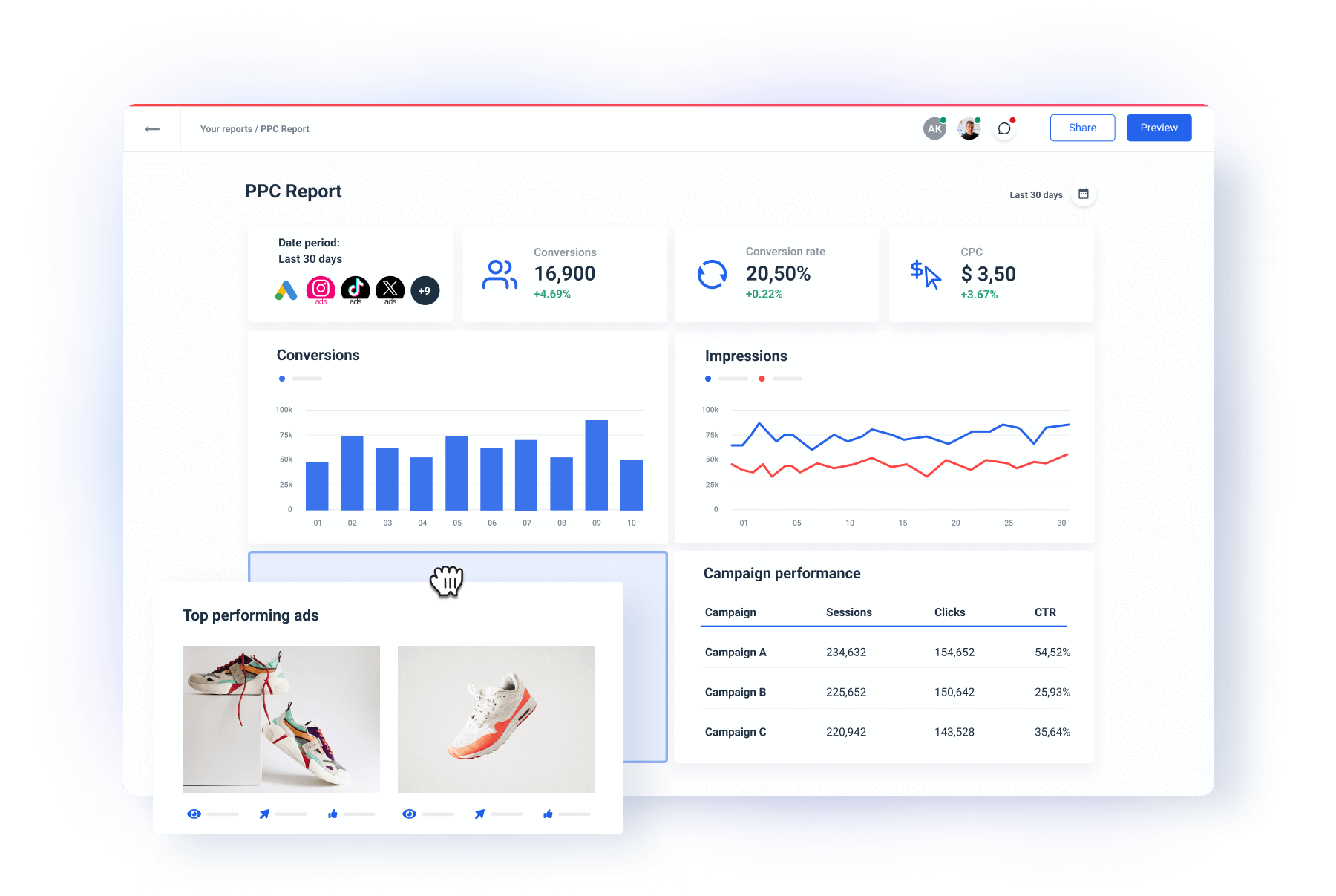 Plus, once you start your journey with us, you’ll be assigned a dedicated Customer Success Manager.
Plus, once you start your journey with us, you’ll be assigned a dedicated Customer Success Manager.
For urgent questions, you can reach out to our live chat support. We respond to chats within 1 minute.
But how does Whatagraph compare against ReportGarden exactly? Let’s take a look:
ReportGarden vs. Whatagraph: Head-to-Head Comparison
Our Product team did extensive research on how Whatagraph compares against ReportGarden and you can find the full breakdown here.
In a nutshell, here are six key ways Whatagraph outperforms ReportGarden:
1. Accurate and reliable data platform
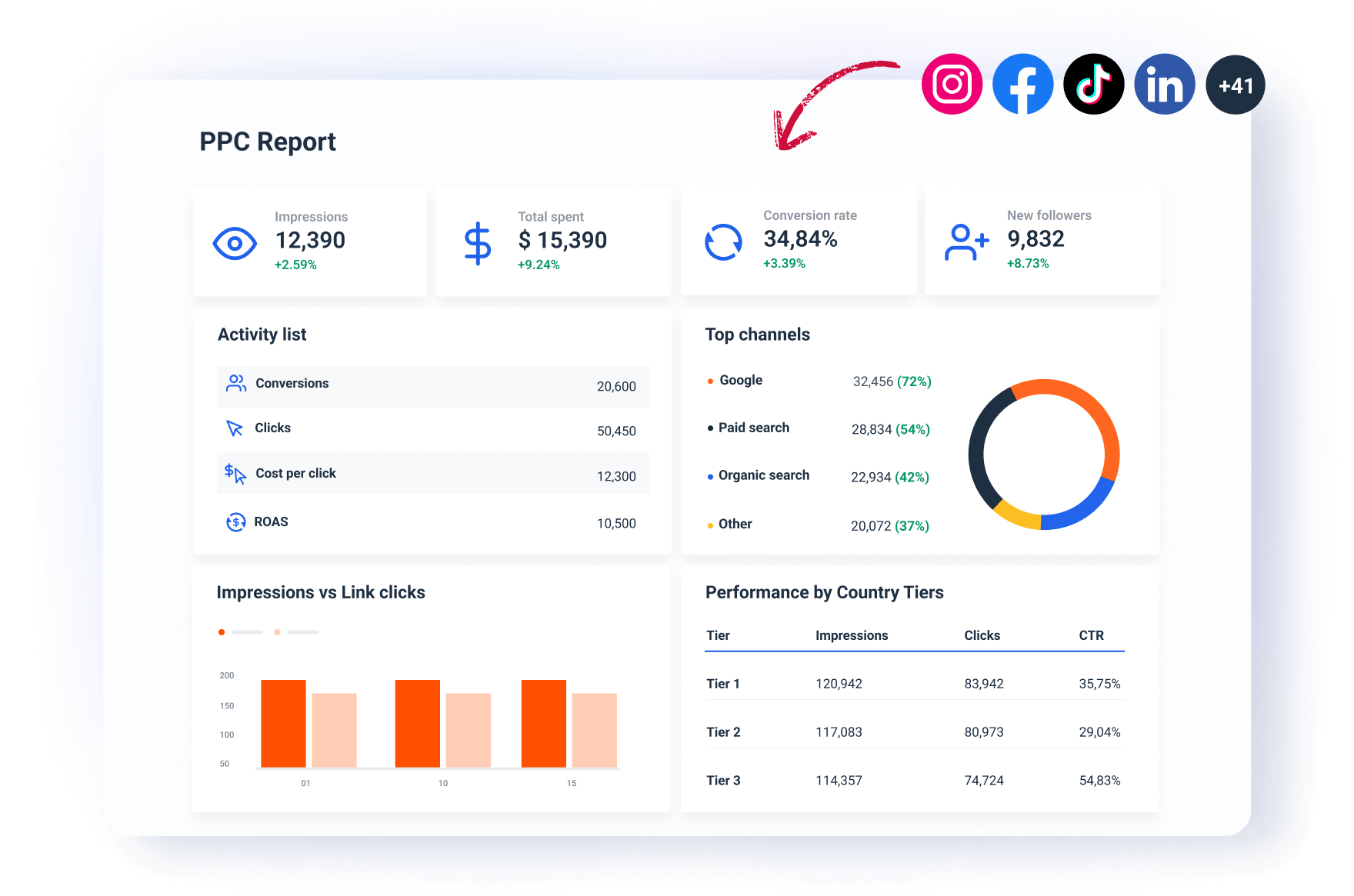 Accuracy is non-negotiable for a marketing reporting platform. The last thing you want is to open up a report 30 minutes before a client meeting and see wonky data.
Accuracy is non-negotiable for a marketing reporting platform. The last thing you want is to open up a report 30 minutes before a client meeting and see wonky data.
With ReportGarden, users experience buggy integrations that don't pull in data accurately from platforms like Google Ads and Google Analytics. This results in bloated or underestimated data on reports.
This is not a problem you’ll experience with Whatagraph.
Our data integrations are fully-managed, meaning they’re built and maintained by our data engineers. These integrations are seamless, stable, and reliable.
And if there are bugs, we can resolve them quickly without having to get a third-party company involved.
A key way we keep your data consistent is by providing a 30-minute refresh rate across all your sources, reports, and blends. This means your data is up-to-date at a consistent rate, rather than sporadically.
According to internal data from the past 6 months, Whatagraph has an average uptime of 99.95%. This means you don’t have to worry about system outages.
Our users love how seamless, stable, and simple the data connection process is. Here’s what one of them said on G2.com:
 Plus, you can transfer your data from Whatagraph to BigQuery or Looker Studio at no additional cost. This is not available on ReportGarden.
Plus, you can transfer your data from Whatagraph to BigQuery or Looker Studio at no additional cost. This is not available on ReportGarden.
All you need to do is:
- Connect to your data sources through Whatagraph
- Organize and prep your data easily
- Pick metrics and dimensions you want to transfer
- Preview your future table
- Start an automated transfer
And your data will flow into your chosen destination automatically.
2. Powerful (but easy) data organization features
If you have 100s of scattered data across different sources, marketing campaigns, channels, and accounts, you need a way to organize them all into unified metrics and dimensions before you visualize the data.
This helps you get a clearer view of performance and keeps your reports neat, tidy, and easy to read.
ReportGarden comes with a basic data blending function and “Calculated metrics” where you can apply simple formulas. But that’s where it ends.
In comparison, Whatgraph offers powerful data organization features that you can set up natively within your report.
Here are some examples of what you can do on Whatagraph:
1. Blend data sources together
Say you want to blend data from Google Analytics 4 and Google Ads. All you need to do is:
- Choose the dimensions and metrics you wish to use inside the blend.
- Select the join type.
- Give it a name and description.
And you’ll be able to use the new blended source inside your report right away.

2. Create new metrics and dimensions
Want to standardize your metrics and dimensions from completely different channels? You can easily create custom metrics and dimensions like so:
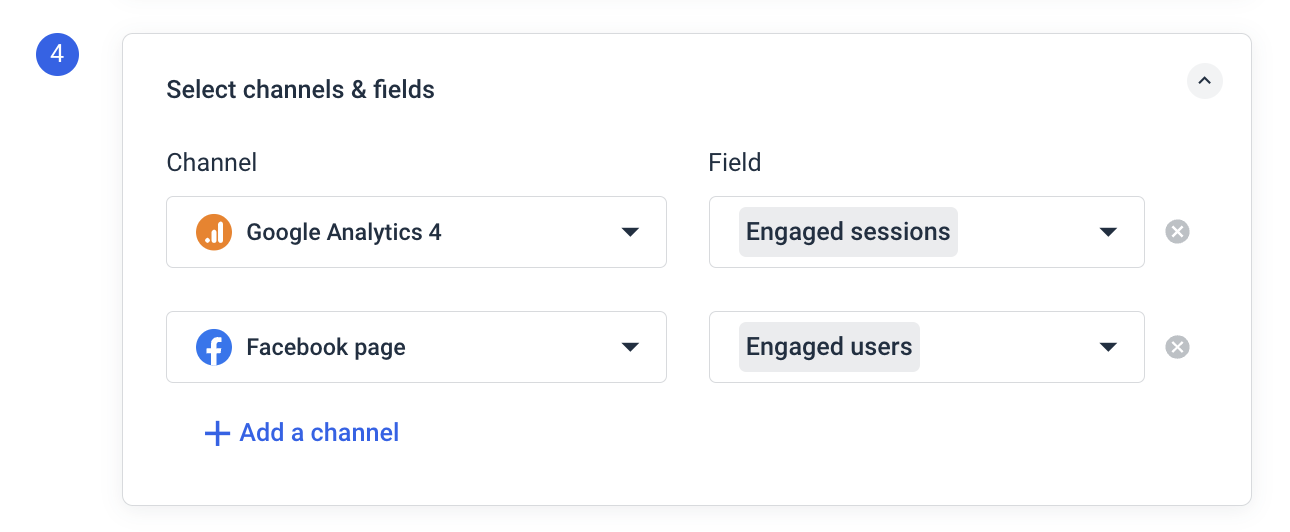 3. Group scattered data sources under one roof
3. Group scattered data sources under one roof
Have 100s of data sources across different locations, channels, and more?
You can combine matching metrics and dimensions from sources under the same category, e.g. Social Media, into one unified Source Group, in seconds.
This means you can report aggregated metrics, e.g. “Impressions from All Social Channels” in one go, rather than one by one.
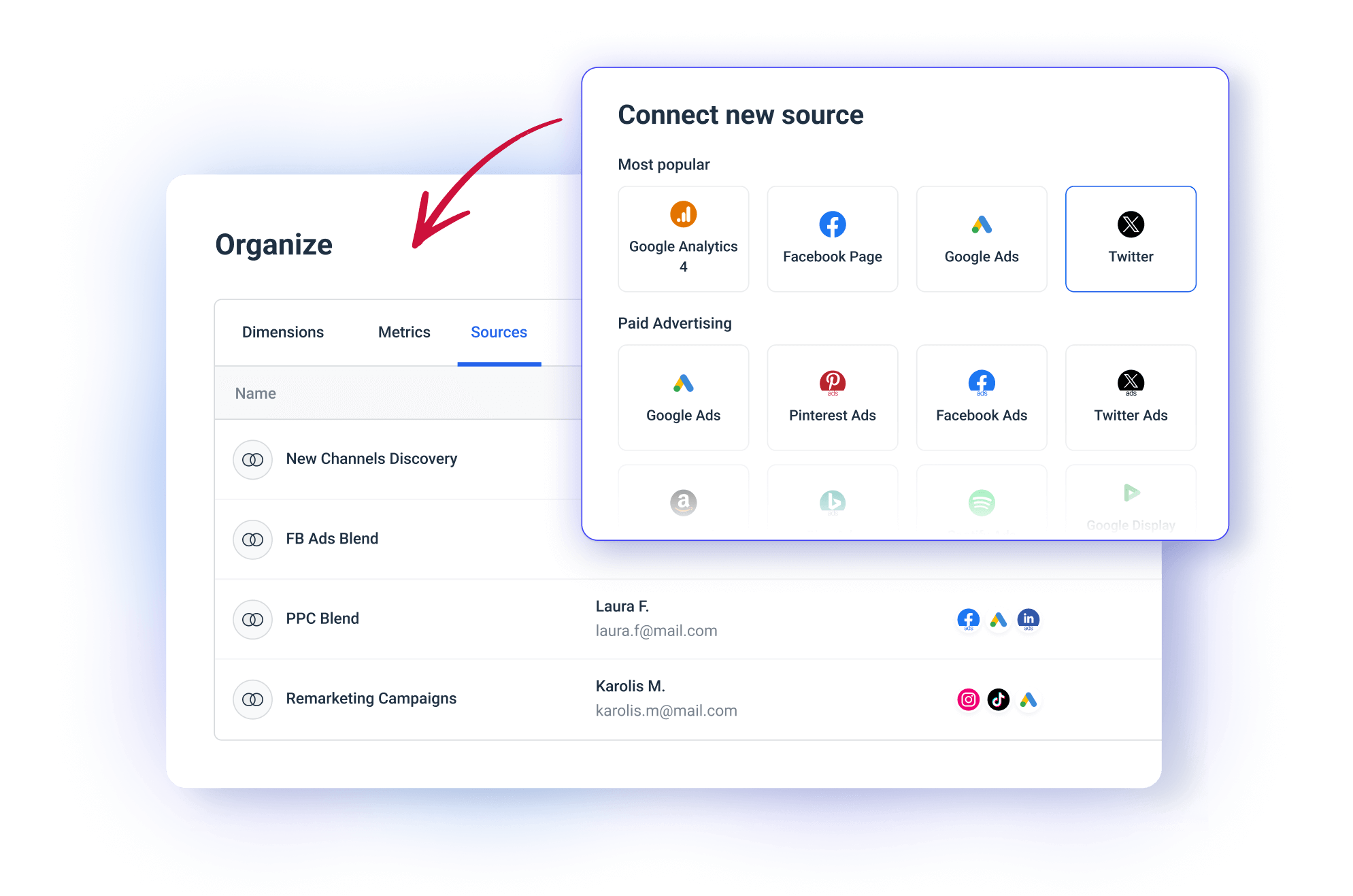 4. Slice and dice your data any way you want
4. Slice and dice your data any way you want
Want to analyze performance by specific Account Managers or clients? You can add custom tags to your data sources, like:
- Clients: “Client A”, “Client B”, “Client C”
- Account Manager: “Bob”, “Karen”
- Location: “Europe”, “North America”
The best thing is you can add ANY tags you want, depending on what makes sense for your business.
Custom tags are a really simple way to reduce clutter and analyze data any way you want.
 5. Visualize and monitor all your key metrics in one view
5. Visualize and monitor all your key metrics in one view
You don’t need to create separate reports to see an overview of your clients’ performance. You can easily create an “Overview” table like so:
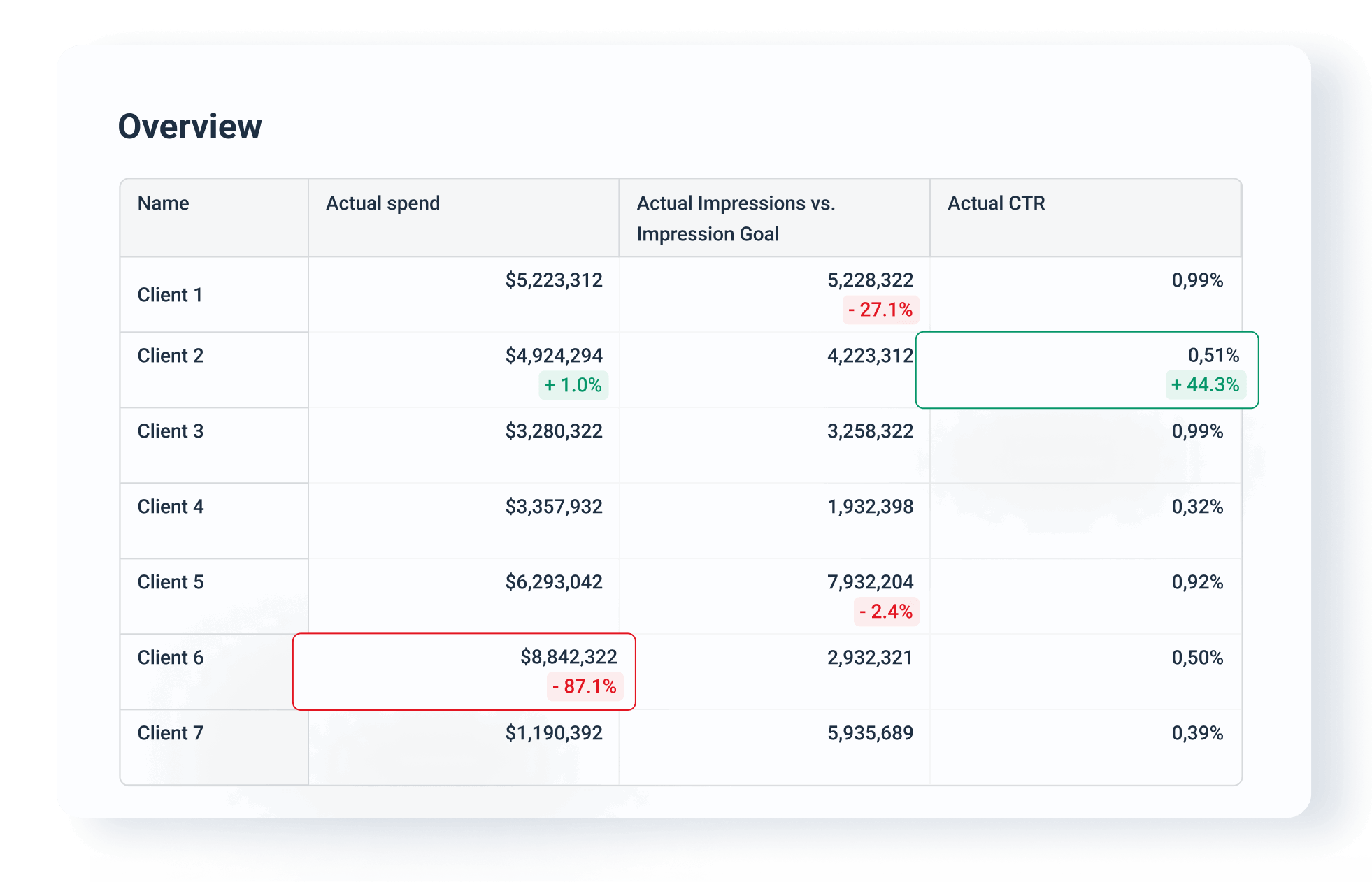 You can also filter these metrics by using custom tags we talked about earlier.
You can also filter these metrics by using custom tags we talked about earlier.
Powerful and easy data organization on Whatagraph means:
✅ Your reports are easier to read, neat, and tidy.
✅ Your clients clearly see the value you’re delivering rather than being stuck interpreting data.
✅ You can get insights in minutes and use them to boost ROI and lower costs for clients.
3. Easier and faster to build and edit visualizations
To create one visualization on ReportGarden, you’ll need to work with three different workspaces:
- Dashboards
- Documents
- Reports
(It’s unclear what is the difference between “Documents” and “Reports”.)
For each of these workspaces, you’ll need to configure different settings and styles from scratch. This is not only time-consuming but also mentally draining.
What’s more, say you want to tweak one section on 20 similar reports you’ve created. On ReportGarden, you’ll need to edit each report individually. This can take you hours.
On Whatagraph, you can link these reports to a single “master” template, and just edit that one template. The changes will automatically sync across all linked reports, saving you hours of work.
The good thing too is that you can still edit text and image widgets in the linked reports without affecting the Master template.
Also, on Whatagraph, you create ONE dashboard and that doubles down as a report (we’ll be using the two terms interchangeably).
White label this report, and download it as PDFs, share live links, or send automated emails to clients.
Building your first report is as easy as 1-2-3. You can either:
- Start from a blank page and use our drag-and-drop widgets to add metrics onto the dashboard.
- Use one of our ready-made report templates or dashboard examples.
- Use our Smart Builder to instantly create dashboards for your favorite marketing channels (e.g. Google Analytics 4, Google Ads).
This video breaks it down in detail:
When it comes to adding metrics, you can:
- Build your own metrics and drag-and-drop them onto the dashboard
- Drag-and-drop pre-made metrics
- Widget templates
- Offline data
- Use Smart Builder
For new users, we always recommend starting from pre-made widgets, which makes life easier and is much faster. You don’t need to write any codes or work with any spreadsheets — just drag and drop on your dashboard and that’s it.
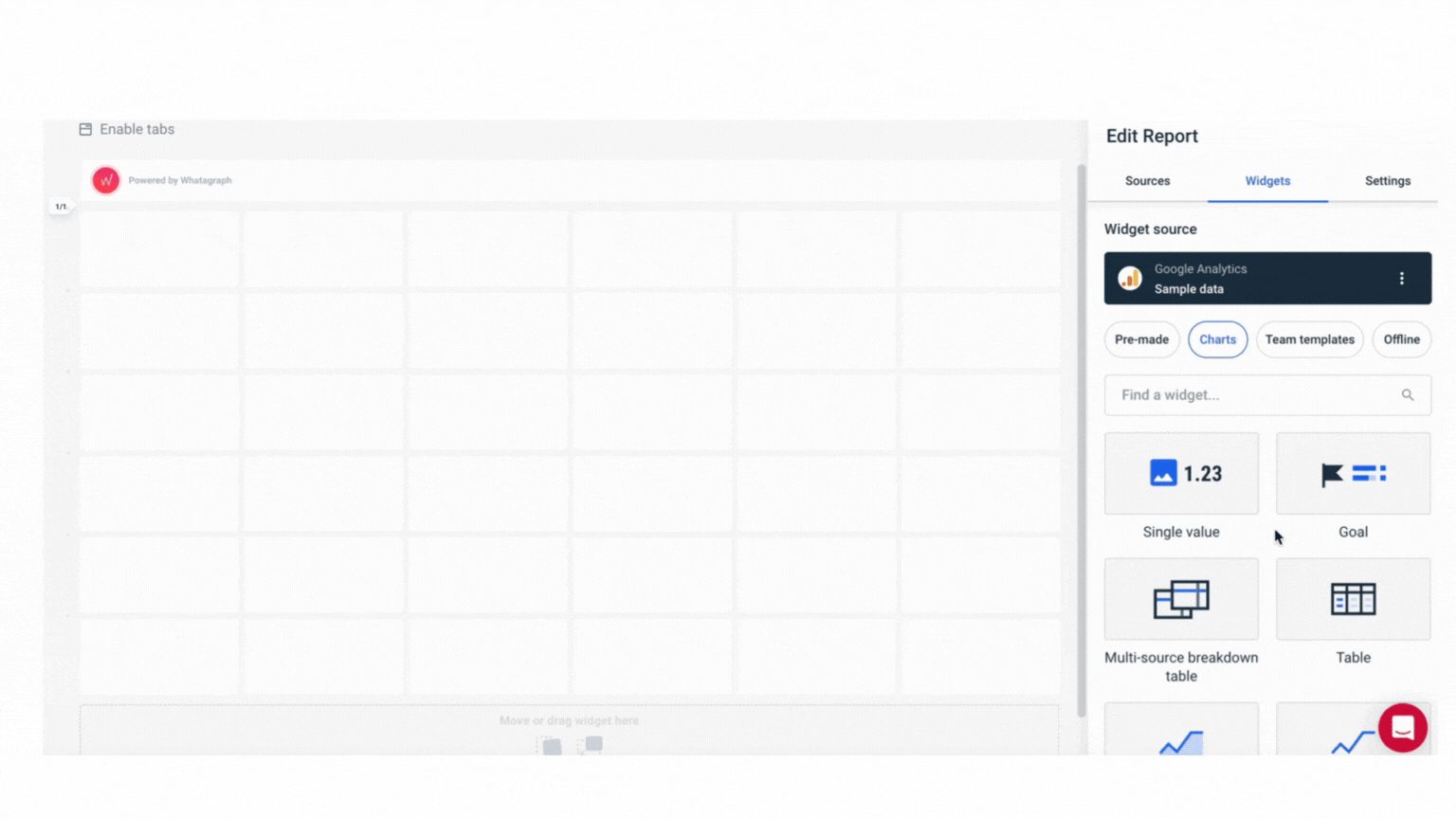
But just because they’re pre-made, doesn’t mean they’re not customizable. You can still:
- Adjust or rename the metric
- Change or remove icons
- Apply custom formulas (e.g. data blends)
- Change date ranges and currencies
- Add or hide footers
- Customize the colors of each widget
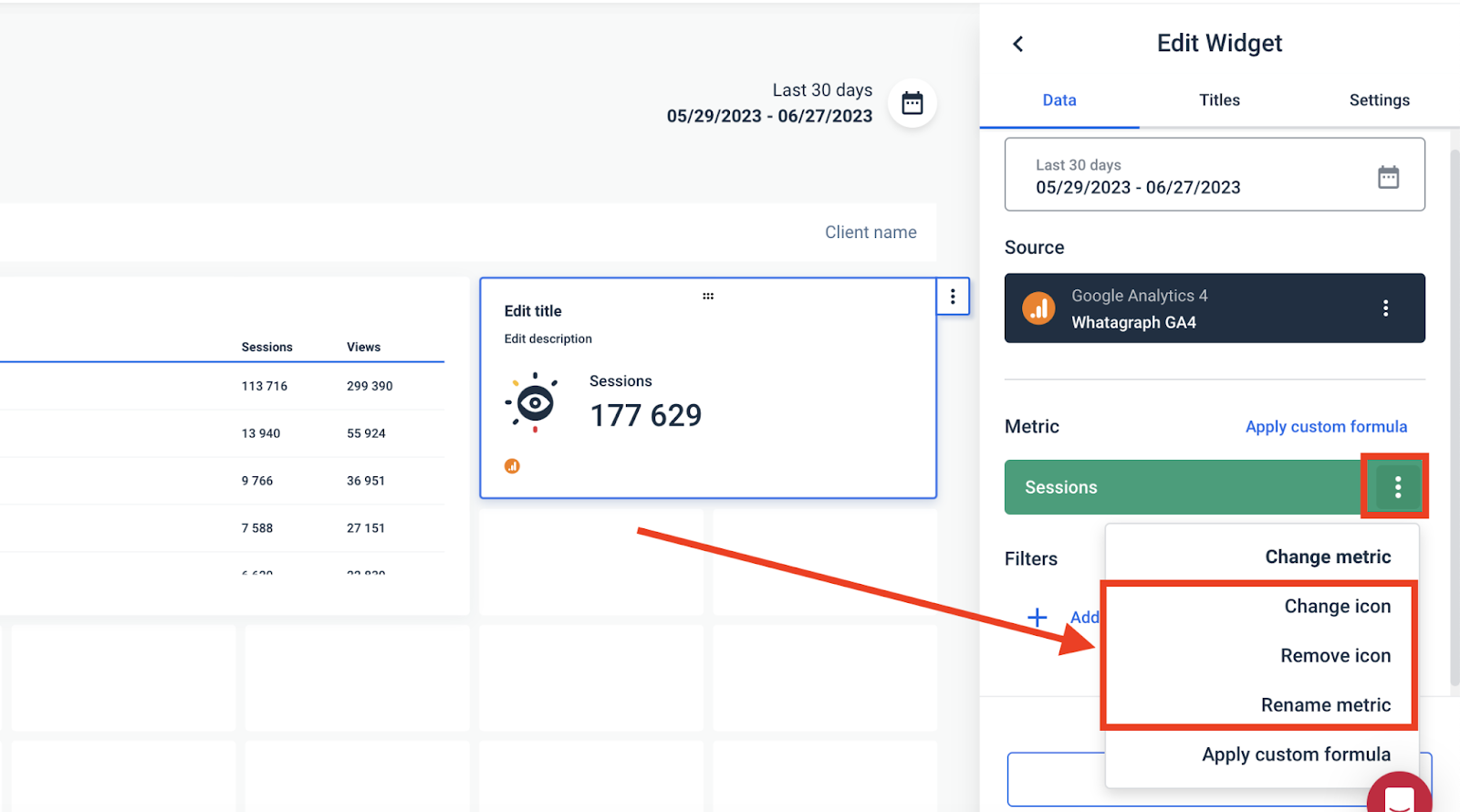 The best thing is you can make all these changes right from your report. No need to jump back and forth from one workspace to another.
The best thing is you can make all these changes right from your report. No need to jump back and forth from one workspace to another.
These widgets are also fully-responsive. You can resize them however you want—horizontally and vertically.
On ReportGarden, you can only save reports as templates and reuse them the next time. On Whatgraph, you can do that both for reports and individual widgets.
Choose any metrics or dimensions you want to show, apply filters, save widgets as templates, and add them to any report you want.
 Want to make your widgets “pop” more? You can add any icons you’d like from our icon library:
Want to make your widgets “pop” more? You can add any icons you’d like from our icon library:
![]() Whatagraph also comes with thoughtful design features that make your user experience smooth as butter. You can:
Whatagraph also comes with thoughtful design features that make your user experience smooth as butter. You can:
✅ Add different “tabs” to one report to show performance for each channel or campaign
✅ Insert or delete rows anywhere on your report
✅ Change your report orientation as Portrait or Landscape
Thanks to these easy but powerful customization options, “Ease of use” is our biggest pro on G2.com, and one user raved:
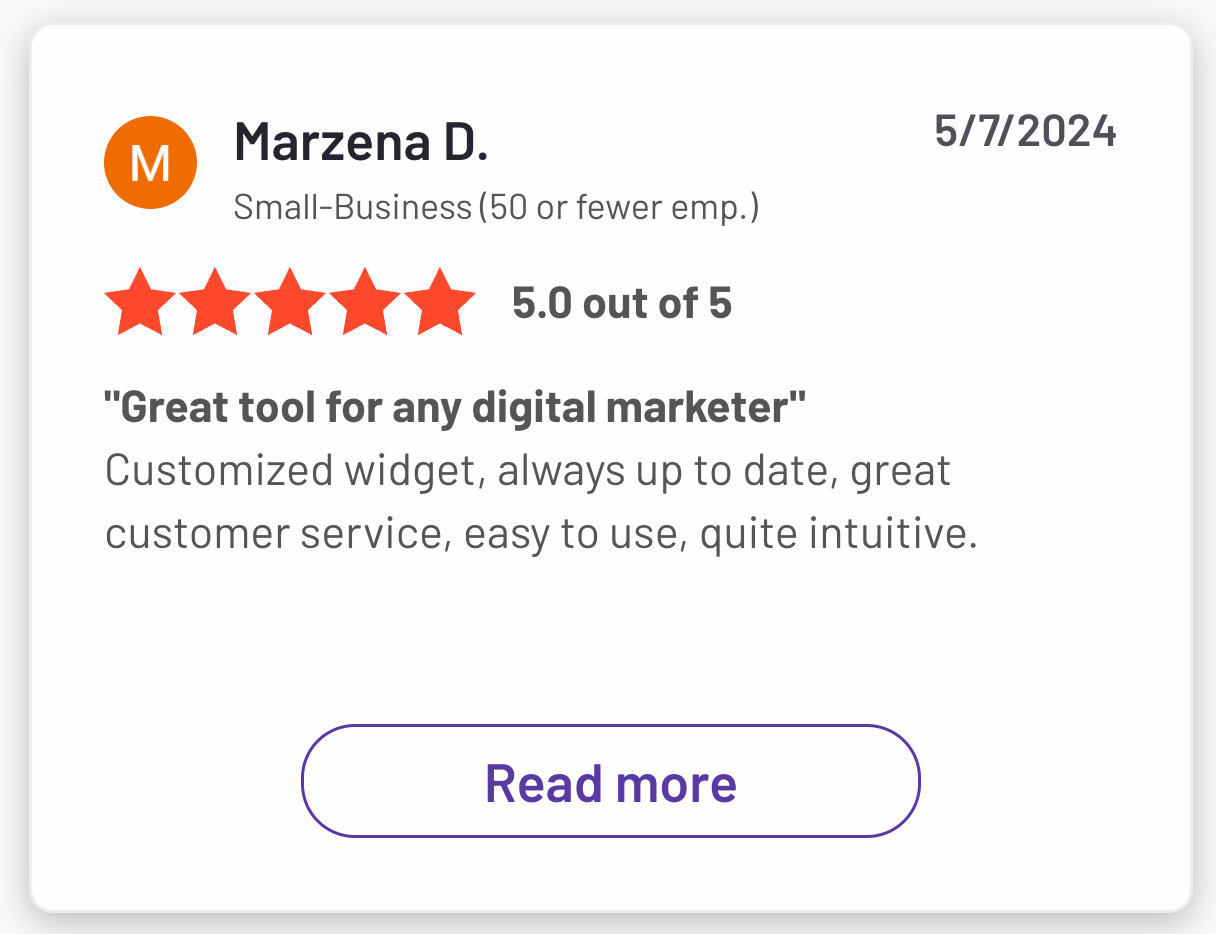
We covered a lot of customization options but these are just the tip of the iceberg of what you can do with Whatagraph. If you’d like to learn more, book a call with us and we’ll show you exactly how we can help.
4. AI chatbot and summaries
ReportGarden doesn't offer AI insights. This means you need to spend extra time to sum up the data, identify trends, potential issues, etc.
The problem is that busy clients often go straight for the insights section, skimming through the rest of the report.
For many of them, that's the only thing they'll read.
Another problem is that digging out valuable insights from the pile of data takes a lot of time.
Whatagraph solves this problem with two innovative AI features that save you time.
AI data chatbot: You can ask our AI chatbot questions about all your connected data or campaigns in natural language—just like talking to your personal data expert.
For example, “What was the total ad spend from Google Ads and LinkedIn Ads in January last year”?
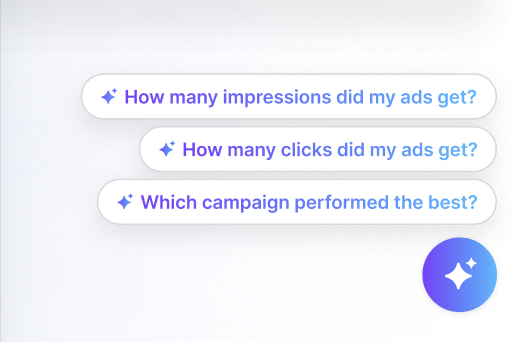
AI summaries for reports: Instead of writing summaries yourself, you can generate AI report summaries and add them to your reports using our Text widget.
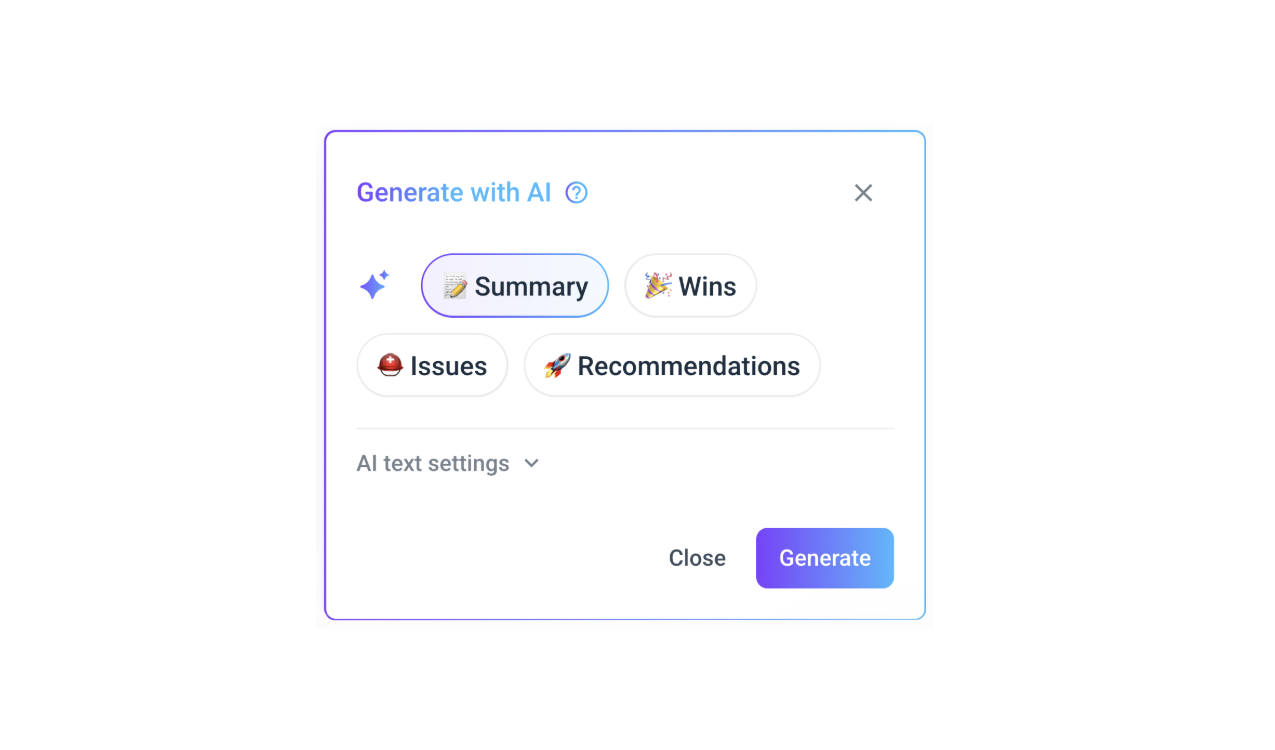
If needed, you can also edit the AI summary to add more granular insights or personal comments.
5. Clean, sleek white-labeled reports
Whether you’re reporting to clients or the C-Suite, the easiest way to impress them is to send a clean, sleek, and branded report.
However, based on examples we’ve seen online, ReportGarden’s reports look old-fashioned and a bit like glorified Word documents.
In comparison, Whatagraph’s dashboards and reports are clean, sleek, and easy to read.
 White-labeling your reports on Whatagraph is also easy. Simply go to “Settings” on your dashboard and:
White-labeling your reports on Whatagraph is also easy. Simply go to “Settings” on your dashboard and:
- Upload your logo or your client’s logo
- Create custom color schemes
- Add footer and header texts
- Create custom domains to host and share your reports
This video breaks it down:
These custom features will then be applied across all your reports and dashboards, saving you massive time. In contrast, on ReportGarden, you’ll need to create a dashboard, then create a report for the same data.
When the time comes for sharing these reports, you can either:
- Send automated emails to specific people at specific times, days, and cadence. Customize the email subject lines, body copy, and even domains.
- Send instant live links to anyone.
- Download PDFs or Excel spreadsheets.
6. Straightforward pricing with Customer Success and Support
ReportGarden offers affordable pricing plans, but they can also be limited. For instance, even in their more advanced plans like “Standard” and “Professional”, you can only connect to a maximum of 70 data sources.
This might work for smaller agencies and freelancers, but it’s not enough for medium to large agencies dealing with 100+ sources.
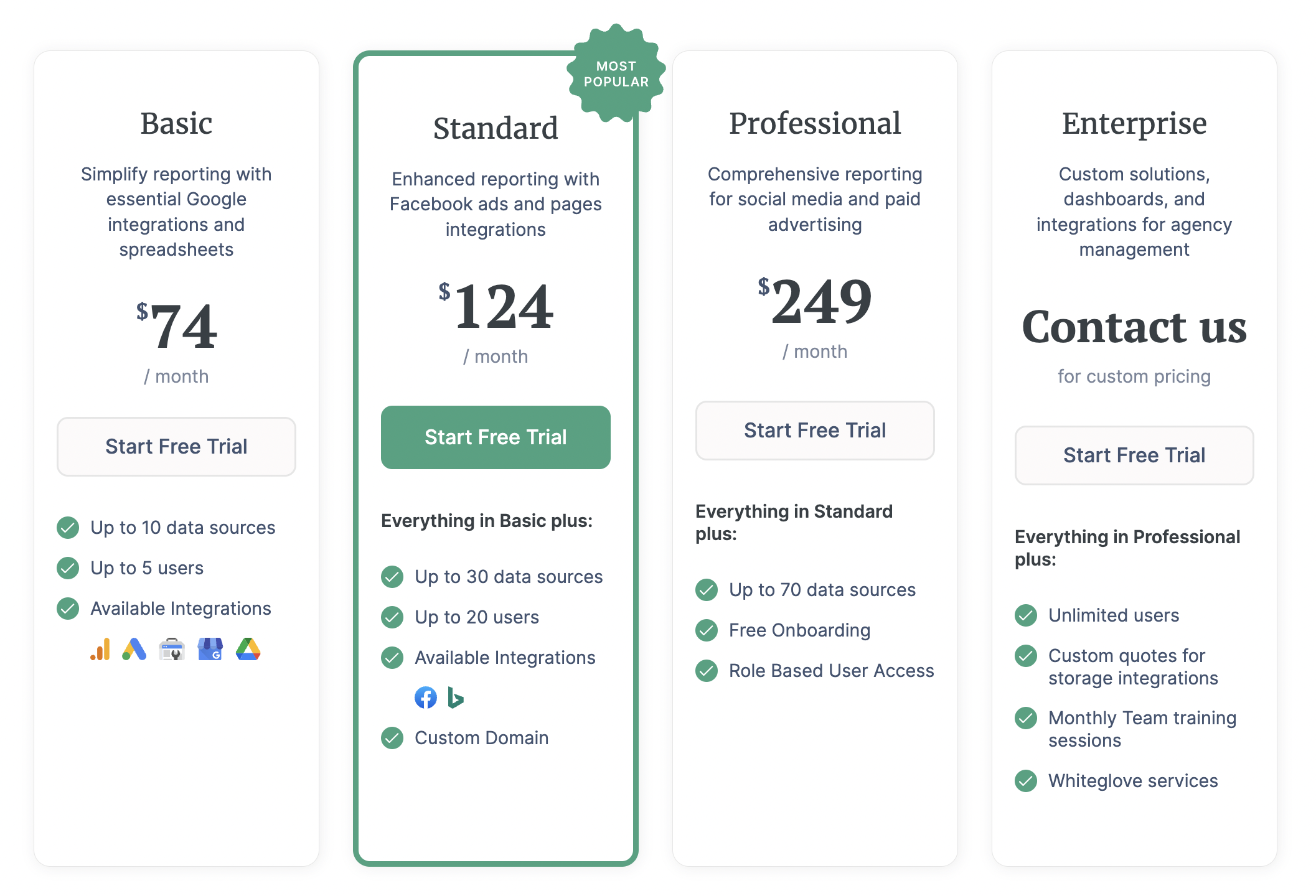 Plus, in the cheaper plans, you can't connect to more niche platforms like Constant Contact, Shopify, and Amazon Ads. These are only available on the “Enterprise” plan which starts from $649/month.
Plus, in the cheaper plans, you can't connect to more niche platforms like Constant Contact, Shopify, and Amazon Ads. These are only available on the “Enterprise” plan which starts from $649/month.
 In comparison, Whatagraph’s pricing is straightforward. All our plans come with:
In comparison, Whatagraph’s pricing is straightforward. All our plans come with:
- 55+ native integrations
- Custom APIs
- Unlimited data blends, custom metrics, and dimensions
- Unlimited dashboards and reports
- Data transfers to BigQuery and Looker Studio
We also believe that Customer Success is a must-have, not an add-on. All our plans come with a dedicated Customer Success Manager + Customer Support.
Your CSM will help you with:
- Connecting to channels and data sources
- Organizing your data
- Creating reports
- Anything else you need
And if you need urgent help, you can reach out to our Customer Support team member through live chat or email at no extra cost.
Convinced that Whatagraph is the right ReportGarden alternative for you? Book a call and tell us how we can help you.
Key Features
- 55+ native integrations
- Custom integrations through Custom API, Google Sheets, or BigQuery
- Versatile drag-and-drop widgets for reports and dashboards
- Custom metrics, dimensions, and data blends
- Currency conversions
- Library of pre-made dashboard and report templates
- Export to Excel and CSV
- Custom branding and white-label features
- Automated report sharing via email
- Links to live dashboards
- No-code data transfer to BigQuery and Looker Studio
Whatagraph Reviews from Real Users
“To me, Whatagraph is like the Tesla or Mercedes of digital analytics tools, their clean and simple way to present complex marketing data. I highly recommend it to anyone working with marketing analytics who values efficiency and clarity in their reporting.” (Source)
“Whatagraph has a simple user interface that is easy to navigate even for those who don't have analytical skills.” (Source)
“What I like best about Whatagraph is having the ability to create reports fast and easy. No more spreadsheets to do reports, they have a great variety of templates.” (Source)
Pros and Cons
Pros:
- All-in-one marketing performance monitoring and reporting solution
- Easy to use by anyone on your team
- Fast campaign performance and insights
- Stunning visual reports
- Makes results easy to interpret
- Excellent live chat customer support
Cons:
- No freemium plan
- Can be expensive for small agencies (under 10 employees) and freelancers
2. Tableau
Most suitable for: Data teams at large enterprises
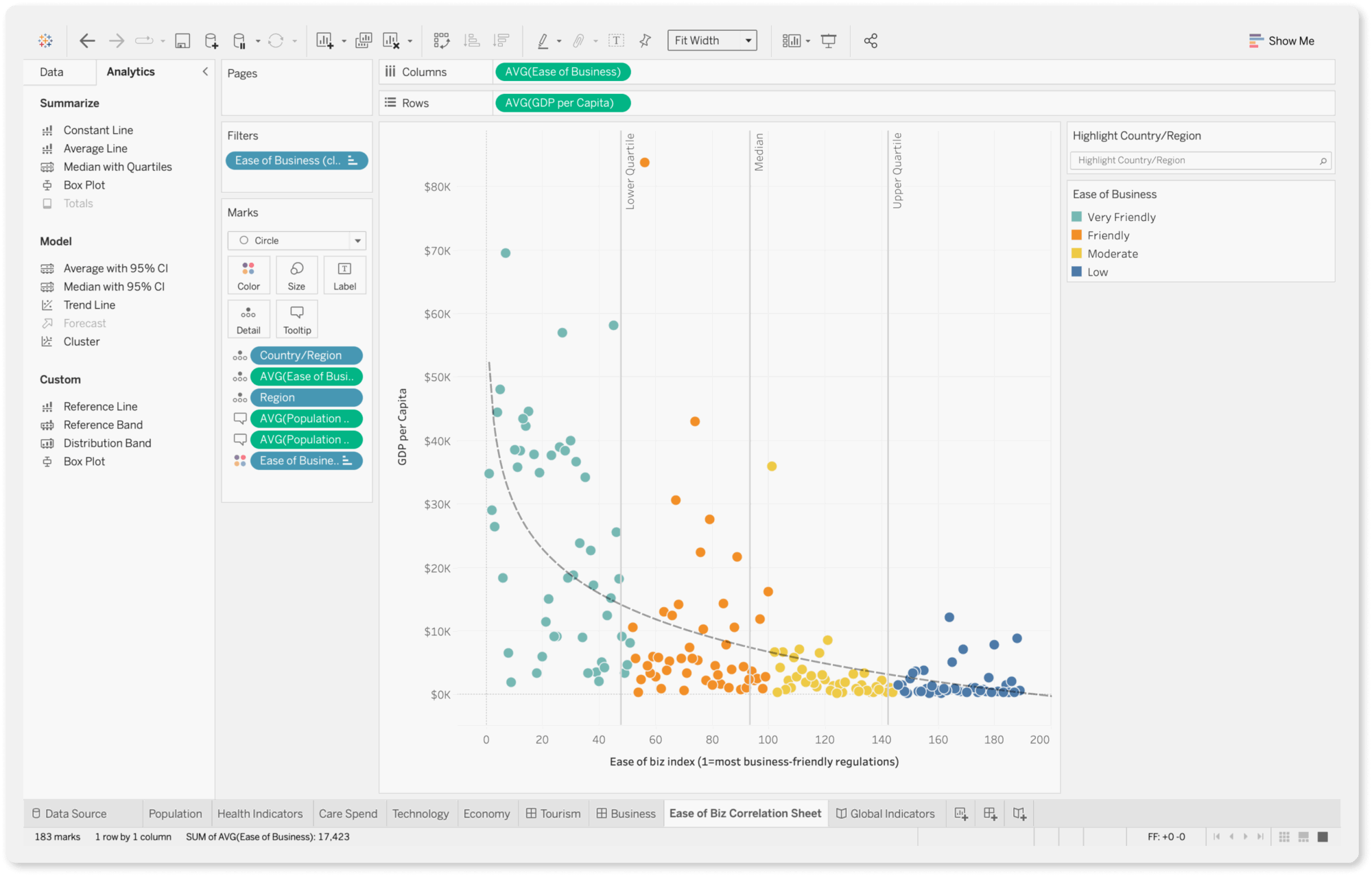 If you’re ready to invest in an enterprise-level business intelligence solution, Tableau is a great choice.
If you’re ready to invest in an enterprise-level business intelligence solution, Tableau is a great choice.
In terms of pricing, this might be a bit of a jump from ReportGarden—but you’ll also get more powerful data exploration features like advanced calculations, statistical functions, and predictive modeling.
You can perform complex data analysis, uncover trends, and identify opportunities for optimization using features such as trend lines, forecasting, and clustering.
Despite these advanced features, Tableau is still (relatively) easy to use with a drag-and-drop interface and visual query builder. You can generate insights quickly and share them with stakeholders through reports. 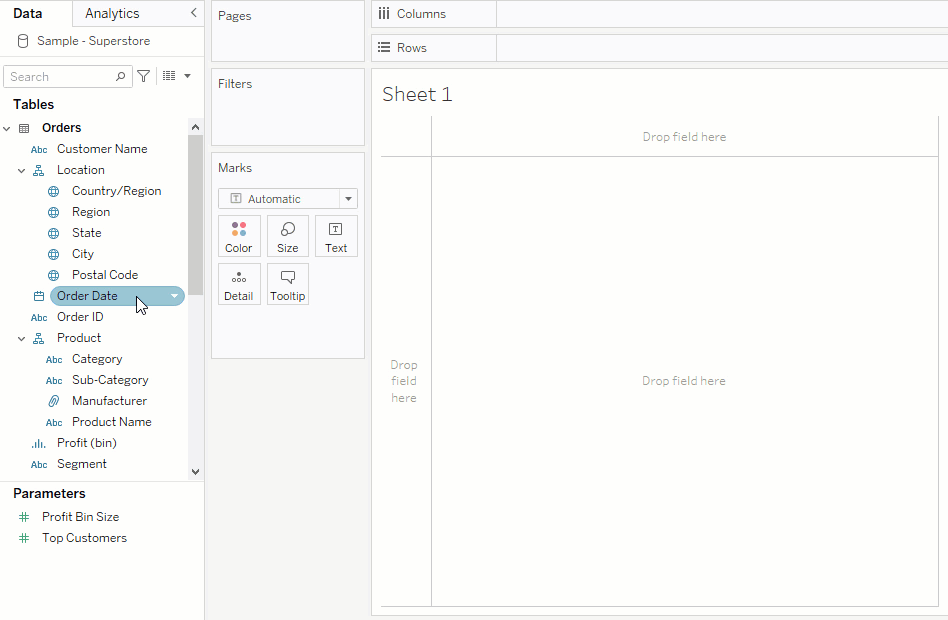
If you need help, you can go to Tableau community forums and ask your questions. A current Tableau user or a moderator will answer you. You can also purchase “Success Plans” that come with personalized training and support.
Personally, I think the best thing about Tableau is “Einstein”, which analyzes your data from all your sources and channels, and points out patterns or insights you might miss on your own.
For example, it can show you which types of ads are attracting the most customers or predict which customers are likely to make a purchase. This helps you make better decisions because you’re basing them on real data, not just guesses.
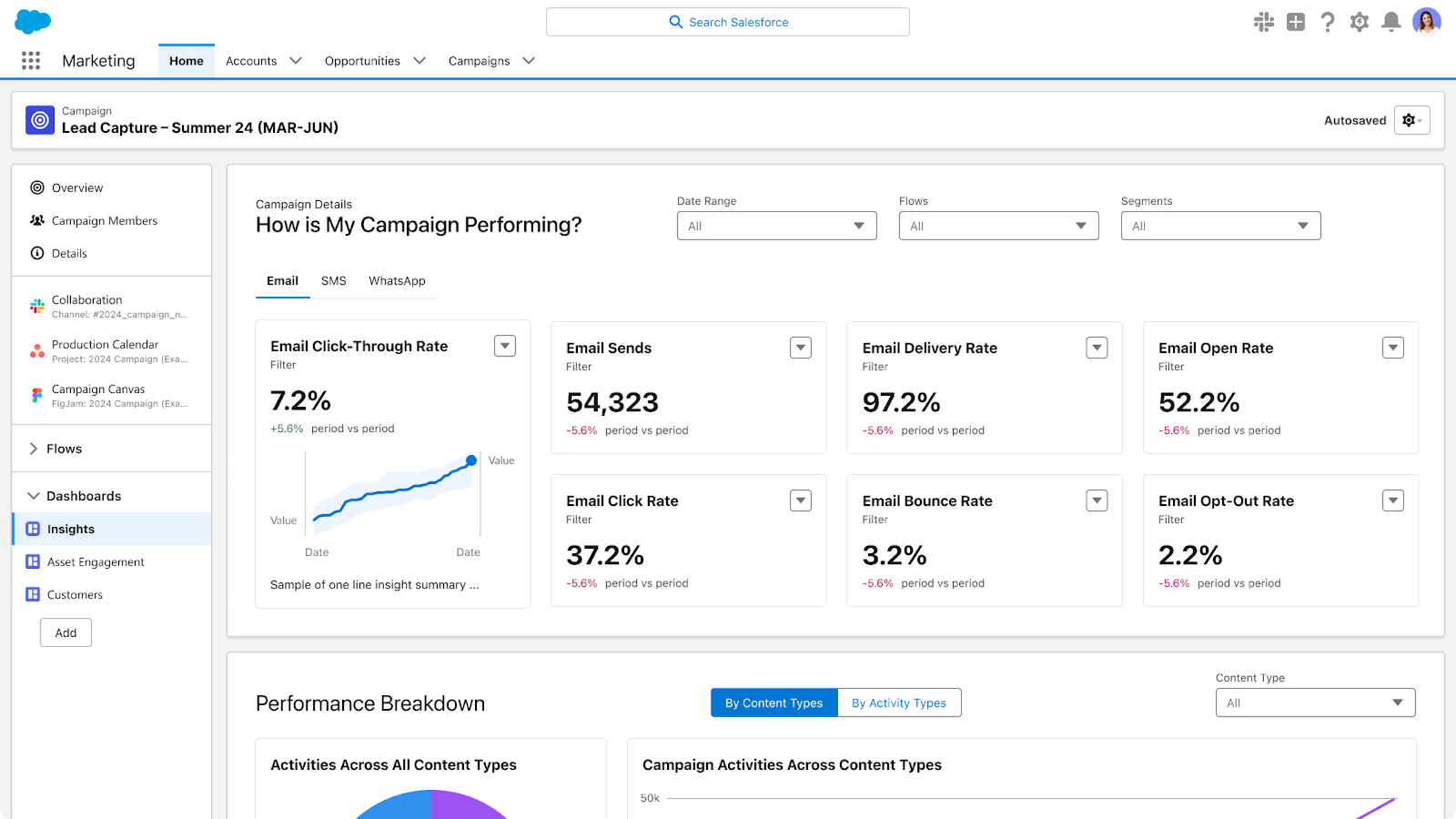
But again, Tableau is a powerful enterprise-grade tool so it can cost you anywhere between $2000-$5000 a month.
Key Features
- 90+ integrations
- Custom metrics and dimensions
- Data blending
- Drag-and-drop dashboard interface
- AI-powered insights
Tableau Reviews from Real Users
“Tableau allows me to create my own structured data from a lot of unstructured data.” (Source)
Tableau has an uncanny ability to transform complex data into visually stunning and easily understandable representations.” (Source)
“Tableau can be costly, particularly for startups.” (Source)
Pros and Cons
Pros:
- Powerful data analytics and visualization
- Easy to use and implement
- Seamless data integrations
Cons:
- Can be expensive if you need advanced features
- Takes a lot of time to load for large datasets
- All the preprocessing of the data (data cleaning) has to be done beforehand. Data cleaning cannot be done in Tableau
Tableau Pricing
As of October 2024, Tableau offers three pricing plans:
- Viewer: $35/user/month, billed annually
- Explorer: $70/user/month, billed annually
- Creator: $115/user/month, billed annually
3. Geckoboard
Most suitable for: Medium to large businesses in the Customer Service, Sales, and eCommerce sectors
Not ready to invest in Tableau? Geckoboard is an affordable and easy to use dashboard software for eCommerce, Sales, and Customer Service businesses.
I wouldn’t say it’s suitable for agencies, however, as their dashboards are mostly built for Inventory and Operations management.
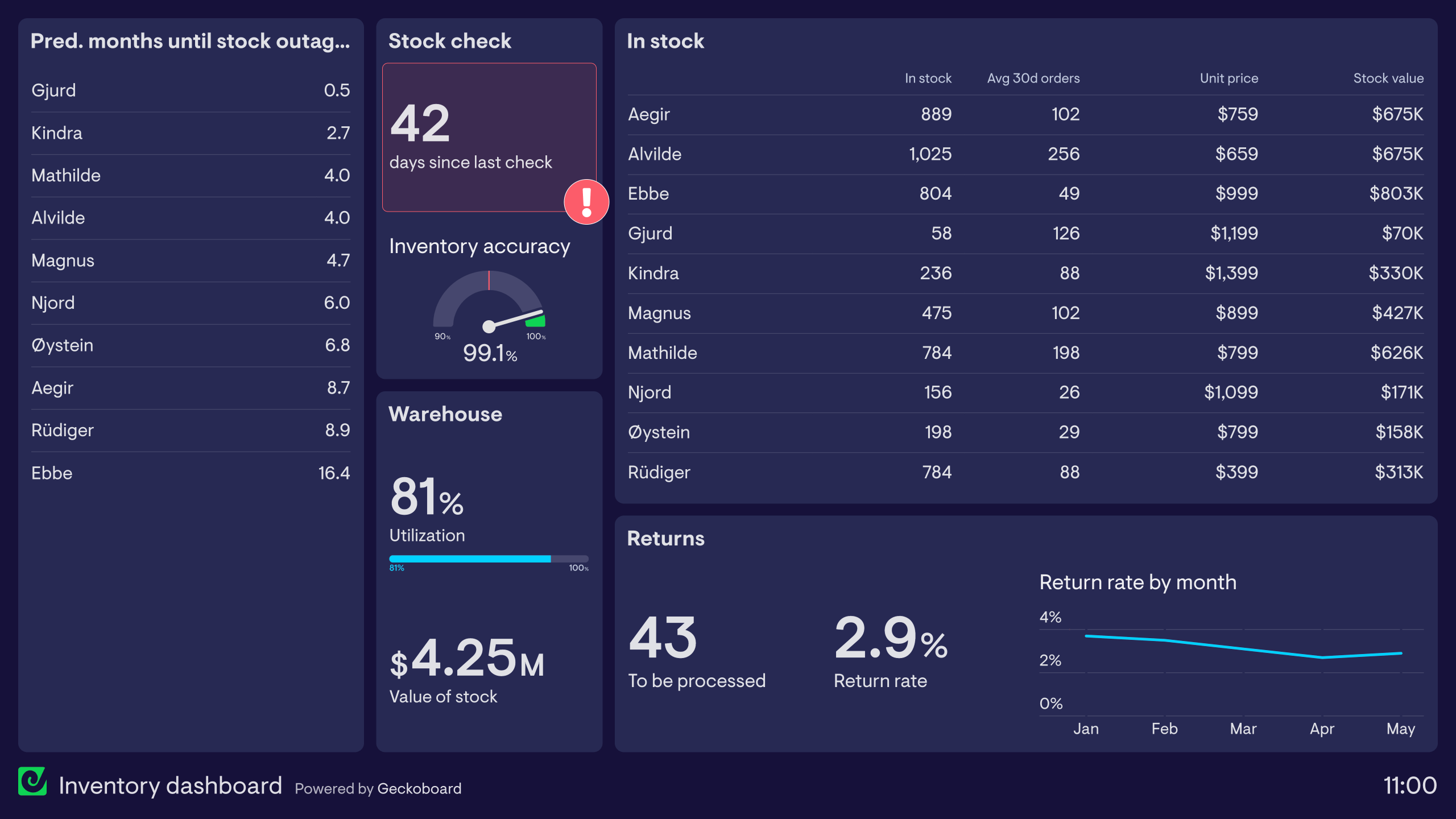
With Geckoboard, you can connect to 90 data sources, design your dashboard, and share the dashboard with your team members or the C-Suite.
Once your data is connected, you can create three main types of dashboards:
- A blank dashboard
- TV dashboards for internal presentations
- Mobile dashboards
- Snapshots and reports
Then, you can send snapshots of these dashboards via Slack and email to stakeholders on a regular basis. ReportGarden does not come with a Slack integration.
However, unlike Whatagraph, you won’t be able to create custom data blends, metrics, and dimensions on Geckoboard. This can be a deal breaker if you’re a large company and you need to organize your scattered data to create easy to read and impactful reports.
Key Features
- 90+ integrations with Customer Service, Sales, Finance, and eCommerce channels
- Drag-and-drop dashboard builder
- KPI notifications
- Slack integration
- Automated email reports
- TV dashboards
- Mobile-friendly dashboards
- Dashboard examples for businesses
Geckoboard Reviews from Real Users
“I love how simple it is to use. That you can connect data from so many different sources in an easy way.” (Source)
“Connecting the dashboard with the Tv works like a charm.” (Source)
“Geckoboard could use more features and options for customization. Compared to other tools like Power BI or Tableau, Geckoboard didn't have as many advanced tools for analyzing data or changing how things looked. I wished I could make more complicated charts and do special calculations.” (Source)
Pros and Cons
Pros:
- Easy to use and set up
- A wide variety of integrations
- Great customer service
Cons:
- Can be pricey if you want to add more dashboards
- Limited customization options for dashboards
- No advanced calculations, blends, and custom metrics and dimensions supported
Geckoboard Pricing
Geckoboard’s pricing is based on the number of dashboards. But unlike DashThis (which includes unlimited users), Geckoboard has limitations on the number of users.
As of October 2024, Geckoboard offers three pricing plans:
- Essential: $149/month for 5 dashboards, 3 users, 1 TV share, and core data sources
- Pro: $199/month for 5 dashboards, 10 users, 3 TV shares, and pro data sources
- Scale: $699/month for 30 dashboards, 25 users, 10 TV shares, pro data sources, and dedicated Support rep
4. Looker Studio (a.k.a. Google Data Studio)
Most suitable for: Freelancers and boutique agencies
Only need integrations with Google platforms? Looker Studio is a great choice.
Looker Studio is a (sort of) free client reporting tool that comes with 21 native integrations with Google-based platforms like Google Ads, DV 360, Google Sheets, and Google Analytics. You can also connect to BigQuery, MySQL, and Microsoft SQL servers on Looker.
If you want integrations outside of the Google ecosystem, you can pay extra for third-party connectors.
Once your data sources are connected, you can use Looker’s drag-and-drop report editor to add:
- Charts, line bars, pie charts, geo maps, area and bubble graphs, data tables, pivot tables
- Filters and date range controls
- Links and clickable images
- Custom text and images
- Custom styles and color themes
You can then invite teams or clients to view or edit your reports, or send them links in scheduled emails.
However, you’ll need to put a lot of elbow grease into getting Looker Studio reports look just the way you want.
In fact, 90% of marketers we’ve talked to say Looker Studio “drives them insane” and they ended up having to hire a dedicated expert to create and maintain reports.
Key Features
- 21 native connectors (free)
- 1000+ “partner” connectors (paid)
- Drag-and-drop report builder
- Data blends
- Custom images and text
- Custom styles and color schemes
- Mobile app
Looker Studio Reviews from Real Users
“I love the way you can present data from multiple sources in one report. I also love the ability to blend different tables and show the information in one chart.” (Source)
“Unfortunately, connectors break quite regularly and reports containing a lot of data can take a lengthy time to load.” (Source)
“Looker studio needs more report downloading options such as Word and PDF.” (Source)
Pros and Cons
Pros:
- Free (to an extent)
- A huge range of data visualization formats and options
- Easy to use for basic reports
Cons:
- Slow loading
- Connection breakages and inaccurate data
- Limited report sharing options (no Word, Sheets, or PDFs)
Looker Studio Pricing
Looker Studio is free for connections with 21 native integrations, which are mostly Google-based platforms.
5. AgencyAnalytics
Most suitable for: SEO and content marketing agencies
AgencyAnalytics is a close Report Garden marketing alternative and a great marketing and SEO reporting tool.
You can connect to 80+ data sources, including major SEO platforms like Ahrefs, Backlink Monitor, and Semrush, as well as social channels like Facebook, Instagram, and LinkedIn.
It comes with a suite of SEO tools like Rank Tracker, Site Auditor, and Backlink Manager, making it easy to monitor and report on your SEO performance. You can track rankings daily, monitor backlinks, and keep up with the competition.
You can also manage clients and staff on the platform through granular user access and permissions.
AgencyAnalytics’ key advantage over ReportGarden is their AI insights. You can ask AI questions about your data and it will give you summarized insights. It can also unearth interesting trends or untapped opportunities.
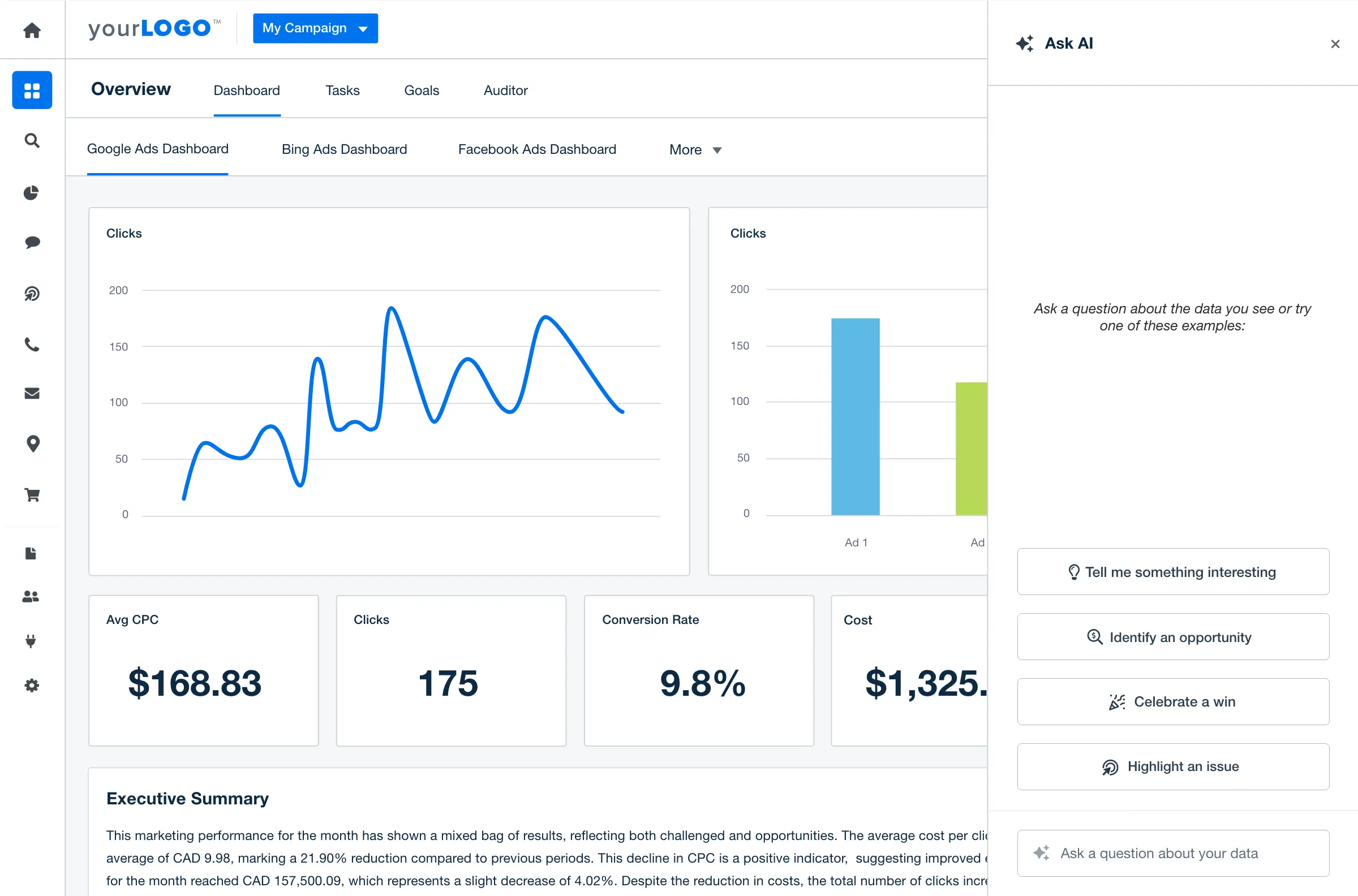
However, users say the platform can be unstable with sources disconnecting frequently due to “service bandwidth” issues. AgencyAnalytics also doesn’t come with advanced data calculations and their dashboards are rigid and limited.
Key Features
- 80+ integrations
- Ready-made report templates
- White-labeling
- Client and staff management
- SEO tools
- AI insights
AgencyAnalytics Reviews from Real Users
“AgencyAnalytics helps me create quick, automated, and clean reports for our clients which saves me a ton of time.” (Source)
“It can sometimes be a little buggy and take time to load. Adding new integrations can sometimes be challenging because of this.” (Source)
“I would like the capability of merging data from different platforms in graphs and metrics (e.g. using data from Google Ads with GA4) in the same section. I also don't like that some platforms aren't yet available (e.g. Reddit).” (Source)
Pros and Cons
Pros:
- Easy to set up and use
- A wide library of ready-made report templates
- Cost-effective
Cons:
- Buggy
- Lack of advanced data calculations and organization features
- Limited integrations
AgencyAnalytics Pricing
As of October 2024, AgencyAnalytics offers three plans:
- Freelancer: $79/month for 5 client campaigns
- Agency: $179/month for 10 client campaigns
- Custom: For established agencies with 50+ clients
6. Swydo
Most suitable for: Small PPC or digital marketing agencies
Swydo is an automated monitoring and reporting platform for marketers. Here are three key aspects of the platform:
- Data collection: Integrate with 32+ platforms and combine your data into one comprehensive report. These integrations include popular channels like Google Ads, Facebook Ads, and Google Sheets.
- Reporting: Create reports easily using templates and their library of metrics and pre-set widgets. Or, add your own customized widgets. Share custom reports as PDF, dashboards, or live presentation.
- Monitoring: Monitor client or stakeholders’ KPIs to quickly identify and address issues and opportunities. Sywdo comes with KPI boards, clients KPI overviews, and alert notifications.

However, Swydo can also be very limiting. Apart from a basic “Custom metric” builder, you can’t blend data sources or create custom dimensions on Swydo. This can lead to messy reports with inaccurate data and inconsistent dimensions.
Swydo is also purely a reporting tool—you won’t be able to ship your data to data warehouses or business intelligence platforms.
Key Features
- 32+ native integrations
- Custom Google Sheets integration
- Custom metric builder
- KPI Monitoring dashboard
- Data filters and markups
- Alerts when KPIs trend up or down
Swydo Reviews from Real Users
“I love that you can customize it as you want, and for social media, you have the little images of the posts next to the results.” (Source)
“Easy to use. The ability to use pre-set templates for each of our products is perfect. Their customer service is also fantastic.” (Source)
“You don't have as much control over how the widgets are displayed on the page. Limited theme and branding capabilities.” (Source)
Pros and Cons
Pros:
- Easy to use and set up
- A wide range of reporting templates for quick-start
- Responsive customer support
Cons:
- Limited data integrations
- Unstable data connections
- No advanced data transformations available
Swydo Pricing
Swydo’s pricing is based on the number of data sources. As of November 2024, the pricing looks like this:
- First 10 data sources: included in initial monthly base fee $49
- 11 - 100 data sources: $3.50 per data source
- 101 - 500 data sources: $2.50 per data source
- 501+ data sources: $1.50 per data source
For example, if you need 100 data sources, expect to pay around $364/month. It’s unclear, however, whether this pricing includes Customer Support and a Customer Success Manager, or if these are extra.
7. Databox
Most suitable for: Boutique agencies and small businesses
Databox is a data reporting and analytics platform for growing businesses.
You can integrate with 100+ software tools, and bring in custom data through Google Sheets or Excel. Then, you can visualize this data directly on Databox using pre-built metrics and templates.
A unique feature that Databox offers that ReportGarden doesn’t is the Benchmark Groups.
You can join “Invite only” groups where users report on key performance metrics across different channels. This way you can benchmark against whether you’re on the right track with your own campaigns.
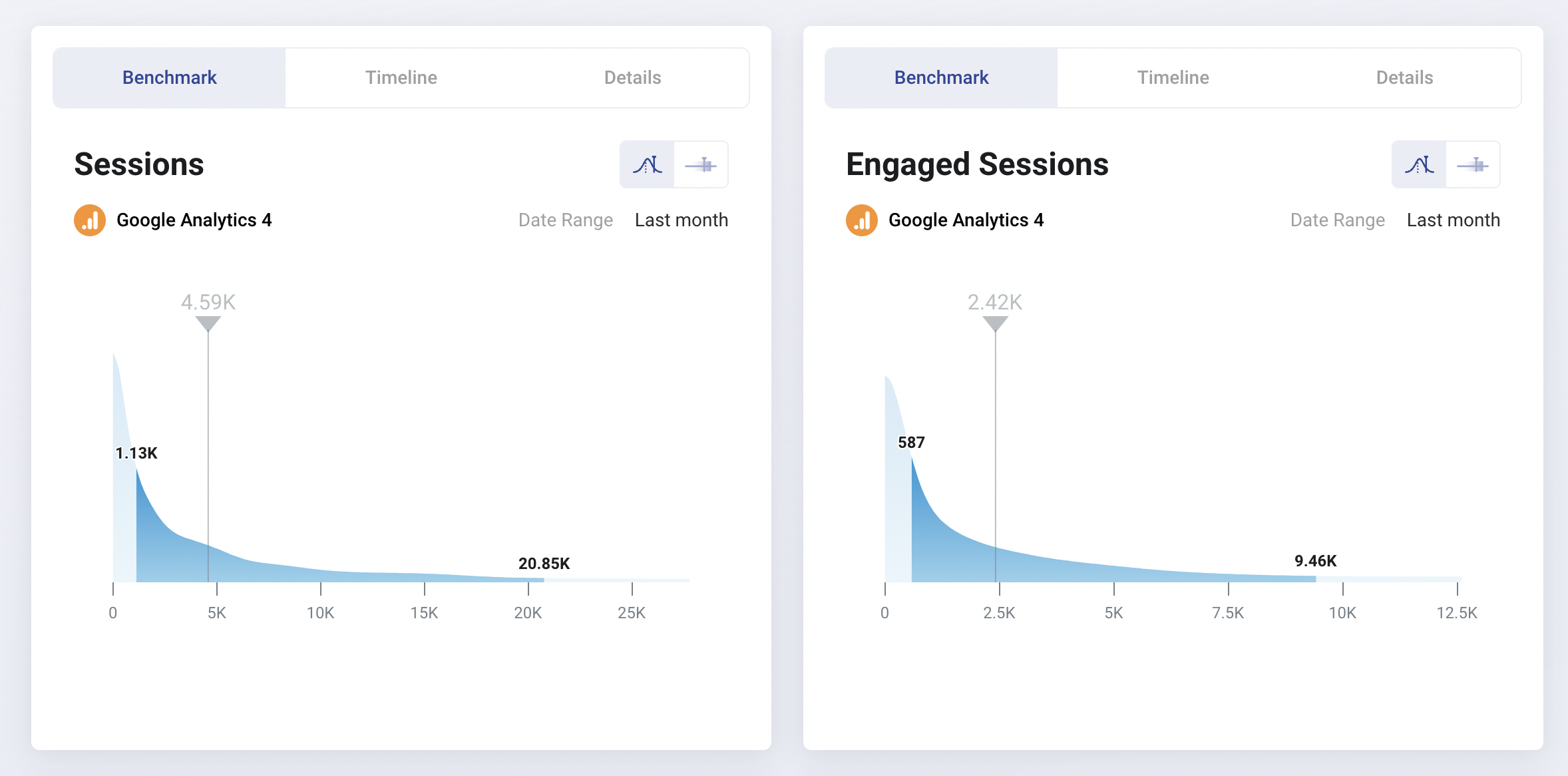 Databox also sends alerts through Slack, email, or app updates when performance trends up or down on your tracked metrics. On ReportGarden, this is only possible through emails.
Databox also sends alerts through Slack, email, or app updates when performance trends up or down on your tracked metrics. On ReportGarden, this is only possible through emails.
However, Databox users say the platform is clunky and difficult to use.
Databox’s reports are also not linked – which means you’ll need to edit them one by one rather than in batch. This can be very time-consuming if you need to tweak dozens of similar reports for clients. On Whatagraph, you can edit them in one-go, saving you massive time.
Key Features
- 100+ integrations
- Native visualization dashboards and reports
- Dashboard and report templates
- Slack, email, or in-app alerts
- KPI benchmark groups
Databox Reviews from Real Users
“Databox makes it simple to interact with data in ways you never thought possible.” (Source)
“I'm not sure what has happened with the customer support team at Databox but they are fairly unresponsive these days.” (Source)
"After 2 years I left. Templates always break, individual metrics always break, lack of good support." (Source)
Pros and Cons
Pros:
- Easy to use
- Wide variety of integrations
- Interactive data
Cons:
- Slow customer support
- Bugs and lag issues
- Broken metrics and templates
Databox Pricing
Databox offers five different pricing plans as of October 2024:
- Free: Limited to 3 users, data sources, and dashboards. No custom metrics, data calculations, or report automation available.
- Starter: $341/month for 50 data sources, 5 users, and unlimited dashboards.
- Professional: $451/month for 50 data sources, 15 users, and unlimited dashboards. Includes custom metrics and data calculations.
- Growth: $681/month for 50 data sources, and unlimited users and dashboards.
- Premium: $999/month for 100 data sources, and unlimited users and dashboards.
White-labeling and “guided onboarding” is also only available as an add-on on Databox ($250 and $500 per month respectively). In contrast, these are included in all of Whatagraph’s pricing plans.
8. DashThis
Most suitable for: Small businesses and freelancers
DashThis is a no-frill marketing reporting tool best suited for small businesses and freelancers. It offers 34 native integrations with marketing platforms, and you can also upload your own data using a nifty CSV file or a Google Sheet.
Once your data is connected, you can visualize it using three key dashboards:
- Periodic dashboards: These are dashboards based on specific time periods and cadence, like daily, weekly, monthly, semi-annually, and annually.
- Campaign dashboards: These dashboards are used to isolate and highlight a specific campaign for a custom date range.
- Rolling dashboards: These dashboards show trends of metrics for three different date ranges.
These dashboards are also pre-made, meaning you can quickly get started.
On the more pricier plans, you’ll get a dedicated product specialist assigned to you who will help you set up your dashboards.
However, DashThis is more suitable as a reporting tool rather than a data analytics platform. There are very few options to customize or organize your data on DashThis.
You can only “merge” widgets together in DashThis; you can’t blend data sources to the full extent or create advanced metrics and dimensions. On Whatagraph, you can easily organize your data any way you’d like using simple workflows.
Key Features
- 30+ integrations
- Custom data upload via CSV file or Google sheets
- Visualization dashboards
- Automatic data refreshes
- Upload client or band logos
- Create custom widgets, domains, color schemes, and email addresses
- Library of report templates
- Report sharing via email, URL, or PDF
DashThis Reviews from Real Users
“DashThis is super user friendly. I am someone who doesn't know too much about Data Dashboards, but this platform was super easy to use.” (Source)
“There are some limitations to what you can bring in and they don't yet offer custom calculations.” (Source)
“It is a little annoying to move things around in a dashboard. You have to move each individual widget to a new section rather than moving an entire section in a dashboard.” (Source)
Pros and Cons
Pros:
- Easy to use and set up
- Many templates and dashboard examples available
- Relatively inexpensive
Cons:
- Limited data organization and customization features
- Limited data integrations
- Basic-looking reports
DashThis Pricing
As of October 2024, DashThis offers four pricing plans:
- Individual: $49/mo or $42/mo, paid yearly. Includes 3 dashboards. No white-labeling features, personalized onboarding, or priority support.
- Professional: $149/mo or $127/mo, paid yearly. Includes 10 dashboards. No personalized onboarding or priority support.
- Business: $289/mo or $246/mo, paid yearly. Includes 25 dashboards, white-labeling, personalized onboarding, and priority support.
- Standard: $449/mo or $382/mo, paid yearly. Includes 50 dashboards, white-labeling, personalized onboarding, and priority support.
9. Grow.com
Most suitable for: Data analysts at medium to large enterprises
Grow is a no-code full-stack business intelligence platform that combines ETL, data warehousing, and visualizations on one platform.
You can connect to 75 data sources through native integrations, including popular CRM platforms, marketing analytics tools, databases, and accounting software.
Then, you can prepare and cleanse your data using either noSQL or SQL transformations. This includes custom calculations, data blends, and advanced data filters.
Plus, Grow stores your data automatically on its platform so you don’t need to ship it to a third-party data warehouse. TapClicks does not have this native storage layer.
You can create three types of dashboards on Grow:
- Dynamic dashboards which display data based on who is logged into the account.
- Dashboard Blueprints which are pre-built, single data source dashboards
- Custom & Sandbox dashboards which shows blended data sources and metrics
These dashboards also come with powerful filtering options based on date, number, or categorical logic.
You can then share them through emails, shareable URLs, Slack, TV-mode, or tables of raw and transformed data.
The platform uses APIs to import data seamlessly from data sources, and it continually refreshes the data so your metrics are up-to-date and reliable.
The key advantage of Grow over TapClicks is their 24/7 customer support via live chat. US-based customers can also call their hotline to get quick answers.
However, Grow is more suitable for internal data storage and monitoring rather than for external reports. Their dashboards are very nitty-gritty which can overwhelm clients or the C-Suite.
Key Features
- 75 native integrations
- Built-in data storage
- SQL or non-SQL based data transformations
- Customizable dashboards
- Advanced data analytics and predictive modeling
- Real-time data updates
Grow Reviews from Real Users
“As an analyst, I have recently started working on this tool and this is by far the best. It helps me to create powerful data visualisation as well as to gain insight from that data.” (Source)
“The interface could be better and overall user experience creates lag sometimes.” (Source)
“The back end seems quite complex to work so really need an IT expert to do the set up, but once it's working it's great for users.” (Source)
Pros and Cons
Pros:
- Inuitive, easy to use interface
- 24/7 customer support
- No-code data pipelines, storage, and visualizations
Cons:
- Occasional lags
- Expensive
- Slow performance when dealing with large volumes of data
Grow Pricing
Grow doesn’t share their pricing publicly.
10. NinjaCat
Most suitable for: Marketing agencies and brands with dedicated data scientists
Similar to Whatagraph and Grow, NinjaCat is an end-to-end platform for connecting to your data sources, cleaning the data, visualizing it, and shipping it to destinations.
You can integrate with 100+ pre-built connectors, ranking from CRM, search advertising, web analytics, and project management tools.
You can then simplify and harmonize your data with no-code transformations and custom calculations. There’s also the option to store your data in a managed warehouse.
Or, you can ship your data to external storage destinations like Snowflake, BigQuery, or Amazon S3, or business intelligence destinations like Tableau and Looker Studio.
When it comes to creating reports, you can start from a blank template (that looks like a “canvas”) and add and adjust metric widgets as needed.
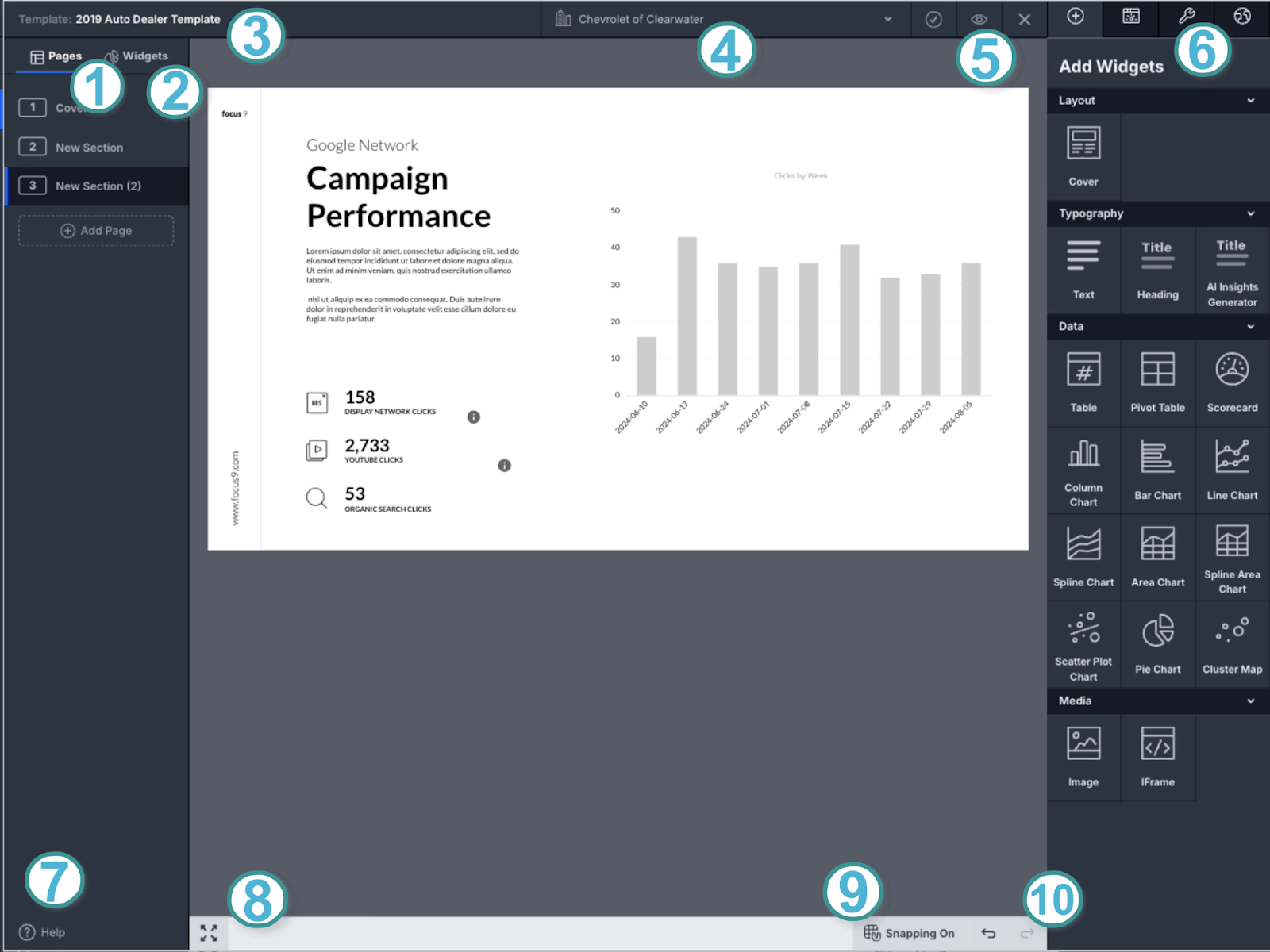 Graphic designers will be familiar with this layout as it looks a lot like a popular design tool—Figma. However, if you’re a marketer without a design background, this can be quite confusing and overwhelming.
Graphic designers will be familiar with this layout as it looks a lot like a popular design tool—Figma. However, if you’re a marketer without a design background, this can be quite confusing and overwhelming.
Key Features
- 100+ pre-built connectors
- No-code transformations and calculations
- Data transfer to BI tools and data warehouses
- Easy ad spend and campaign performance monitoring
- White-label options
- White-glove setup and service
NinjaCat Reviews from Real Users
“I love how it pulls in our data across several different platforms into one cohesive report.” (Source)
“The support the NinjaCat provides is exceptional.” (Source)
“I found a lot of the functionality on Ninjacat to be really clunky, unfortunately things take a LONG time to process if you're adding more than one filter to a table.” (Source)
Pros:
- Automated client reporting
- One platform for integration and visualization
- Multiple choice of destinations
- Custom branded reports
Cons:
- Separate workspaces to organize and visualize data
- Complex visualization builder
- Performance issues with reports
- No autosave in case of a crash
Pricing
NinjaCat doesn’t offer fixed pricing plans, and no information is available on its website.
11. TapClicks
Most suitable for: Enterprises with dedicated data scientist teams
TapClicks is a comprehensive marketing automation solution—from data ETL to reporting to project management, you can do it all on TapClicks.
Here’s a breakdown of all the products it offerS:
- TapData: Extract, transform, and load your data from one platform to another. Create data blends and complex transformations to format your data how you need it.
- TapReports: Visualize, optimize, and share your data with clients in customizable dashboards and automated reports.
- TapAnalytics: Discover trends and opportunities from your data.
- TapInsights: Get AI-powered insights and recommendations to optimize your campaigns.
- TapOrders: Automate orders and enter client objectives and goals at the point of sale. Connect a CRM, import files and create online forms for any product. Best for eCommerce businesses.
- TapWorkflow: Automatically route tasks based on your business processes and streamline your fulfillment workflow. Best for project managers.
- Raven by TapClicks: Perform site audits, rank tracking, link-building, and keyword research with in-depth insights and analysis. Best for SEO managers.
- Competitive Intelligence: Get local SEM data intelligence to create better proposals and to win more clients.
ReportGarden does offer similar products like invoicing (TapOrders) and SEO analysis, but AI insights and competitor intelligence are unique to TapClicks.
However, online reviews say TapClicks is clunky. Their connections break constantly, the data on reports is inaccurate, and the platform is difficult to use (even with 6 months of support from a CSM).
Key Features
- Wide variety of integrations (their website doesn’t say exactly how many)
- Advanced data calculations
- Data Exporter to load data into data warehouses, databases, and data visualization tools
- Interactive dashboards
- AI-powered insights
- Report automation
TapClicks Reviews from Real Users
“What I like best about TapClicks is that it simplifies marketing data by pulling everything into one easy-to-use dashboard.” (Source)
“I dislike TapClicks because the initial setup can be a bit overwhelming, and sometimes the data syncing isn't as smooth as I'd like.” (Source)
“After months of calls and time invested, we still had inaccuracies in the data.” (Source)
Pros and Cons
Pros:
- Powerful data analytics
- Customizable and interactive dashboards
- Responsive customer support
Cons:
- Steep learning curve
- Data inaccuracies
- Connection issues and lags
TapClicks Pricing
TapClicks’ pricing can be confusing as you’ll need to build your own packages.
You start by choosing your data package:
- TapDataLite: $99/month for 64 connectors
- TapData+: $349/month for 250+ connectors
- TapData Max: $649/month for 250+ connectors and API access
Then, you choose your data destination:
- TapReports: $199/month
- TapAnalytics: $899/month
- TapInsights: $1399/month
- Third-party destinations: Custom pricing
All packages come with 10 clients and unlimited users.
Based on these pricing plans, the total cost of TapClicks can come down to 1000s of dollars a month if you want a complete data stack.

WRITTEN BY
YamonYamon is a Senior Content Marketing Manager at Whatagraph. Previously a Head of Content at a marketing agency, she has led content programs for 5+ B2B SaaS companies in the span of three years. With an eye for detail and a knack for always considering context, audience, and business goals to guide the narrative, she's on a mission to create genuinely helpful content for marketers. When she’s not working, she’s hiking, meditating, or practicing yoga.